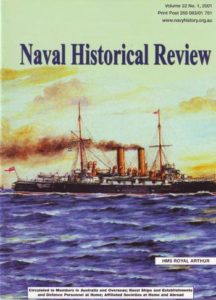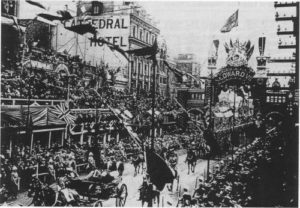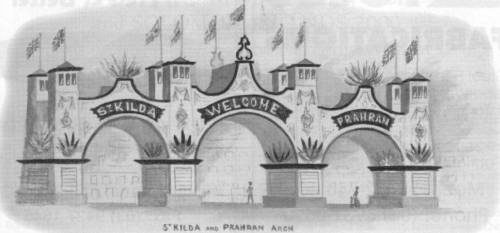- Author
- Ogle, Brian
- Subjects
- History - general
- Tags
-
- RAN Ships
- None noted.
- Publication
- March 2001 edition of the Naval Historical Review (all rights reserved)
Ophir in Australia
The Duke and Duchess were greeted with tremendous acclamations of faith, loyalty-and pride in every Australian city. The year 1901, with the death of the old Queen and the rising belligerency of Germany’s Kaiser was of increasing concern for both Whitehall and far-flung white-governed Australians. In addition to the Royal Empire Tour the Commons voted £16,000,000 for the construction of 15 new battleships and 22 armoured cruisers (less than the 2001 cost of 1 x Collins class submarine).

Painting by John Bastock
Of the ships of the former colonial navies in Australia only HMCS Protector from South Australia was a seagoing proposition. The Commonwealth naval force was the Auxiliary Squadron of which John Bastock’s HMS Royal Arthur (pictured right) was flagship. Antiquated as they were, these ships manned by the R.N., were our only seaboard protection and good and safe reasoning for welcoming the Imperial party.
In Melbourne on May 9th 1901 the Duke and Duchess opened the first Commonwealth Parliament and of all cities Melbourne impressed the British Tars with its spectacular triumphal arches, illuminations, decorations and particularly the welcome of the citizens. To quote Price: “I was treated better than if I was at home with friends and relations by a teeming population of Britishers to the backbone.”

Sydney was a disappointment. The city had celebrated earlier (January 1st 1901) the inauguration of the Commonwealth with a massive turnout of 60,000 in Centennial Park and, as is the aftermath of the Olympic Games, had little coin left with which to entertain Duke, Duchess and retinue. One redeeming feature was Royal Naval House in Grosvenor Street. “Johnnies”, as it came to be known in its infancy, was as happy a retreat for the naval lower deck as it was in two later world wars
Adelaide, Hobart, Perth, Albany, New Zealand each responded to the 1901 Royal Tour with resounding expressions of loyalty. Brisbane, suffering from an outbreak of plague was journeyed to by train to avoid any problems with quarantine, should the Ophir crew be involved. On July 26th 1901 HMS Ophir said farewell to Australasia as she sailed from Fremantle westward to Mauritius, Africa, Canada and home. The huge crowd ashore sent up “a tremendous cheer” as the local band played “The King” and Ophir’s band “Auld-Lang-Syne”. Thence the crowd sang “Rule Britannia” and “Home Sweet Home”. Price wrote that “the crowd became very quiet except for one man who stood on his head.”
The Duke turned to the crew of the Ophir and cried, “Three cheers for Australia” which was given right heartily and reciprocated by the crowd cheering for the monarchy.

Brian Ogle M.A. Sydney Member




